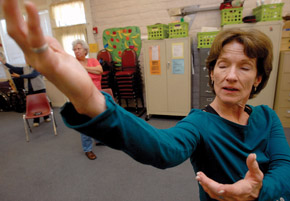
Tai chi offers stress relief and other benefits
On Thursdays at mid-morning a dozen women gather in an activity
room at the Hollister Community Center at 300 West St. Some of them
sit while others stand. They all raise their arms with slow,
deliberate motions. At the head of the room is Elaine Frey, a tai
chi instructor, who leads the women through the movements that make
up the ancient art.
Tai chi offers stress relief and other benefits
On Thursdays at mid-morning a dozen women gather in an activity room at the Hollister Community Center at 300 West St. Some of them sit while others stand. They all raise their arms with slow, deliberate motions. At the head of the room is Elaine Frey, a tai chi instructor, who leads the women through the movements that make up the ancient art.
At the front of the class, Frey dresses in form-fitting yoga pants with loose pant legs and a long-sleeved shirt. Her shoes resemble ballet flats, and the clothing allows her to move easily through the form. Soft music plays in the background.
Frey has been practicing tai chi for years and started teaching classes a year ago.
“It evens out anything you’ve been doing because you have an injury or had an injury,” Frey said. “With tai chi, one of the benefits is that there are always ways to learn what this side of the body can do.”
As Frey talks her students through different movements, it becomes clear that the exercise is about creating balance in the body – shifting weight from one leg to another, shifting weight from front to back.
Frey teaches tai chi at the community center through a Gavilan College non-credit course and the Thursday class from 11 a.m. to noon is free. She also offers a class through the YMCA from 7 a.m. to 8 a.m. on Thursdays for $30 a month.
“I had one gentleman at the Y with a football injury from 30 years ago,” she said. “He would always take steps downstairs with his good leg.”
Frey was able to show him through the weight shifting required in tai chi that his “weak” leg was just as capable of supporting him.
“He built up strength in a leg he has babied so much,” she said.
One of the reasons Frey was drawn to teach tai chi locally is that it is an exercise that can be performed by people of any age and abilities.
“One of my teachers who taught yoga said they learned tai chi because, ‘I need something I can do for life,'” she said.
Even yoga can be hard on an older body or someone not in as good shape.
“They get into extreme stretches and hold it,” she said. “As you get older you can tear muscles or injure yourself somehow.”
Mayo Clinic research confirms Frey’s ideas that tai chi can be good for anyone of any age.
“Anyone, regardless of age or physical ability, can practice tai chi,” according to an article on the clinic’s Web site. “It doesn’t take physical prowess. Rather, tai chi emphasizes technique over strength.”
Frey said she discovered the exercise when a chiropractor she was seeing suggested she might enjoy it. She found an instructor who was well into his 80s.
“I could see how energetic and vital he was,” she said. “I wanted the detail – precision. I wanted to learn it how it was handed down through the ages.”
Tai chi was developed in China 2,000 years ago as a self-defense.
“Qi Gong has the same specific principles, but was never developed into martial arts,” Frey said. “[Tai chi] was designed by guys who thought their soldiers were out of shape.”
There are more than 100 movements and positions in tai chi, and Frey’s class at the community center has just started learning a few of them.
One woman at the class said her doctor was happy to hear she had signed up.
Frey is a patient teacher who takes the time to not just correct her students’ form, but also to ask questions that help her understand why a student may not be doing the complete movement.
On a recent afternoon, a student talked about an arm injury that made it difficult for her to move her left arm through some of the movements.
“Maybe I could help you with some movements that could help you to keep it from getting weaker,” Frey told the student.
Tai chi is a practice that requires patience, however, and those who truly want to know it should be prepared to invest some time into it.
“Our world, our culture doesn’t have patience,” Frey said. “You have to be patient with yourself, and don’t become frustrated, and you will get it.”
Classes:
Thursdays from 7 a.m. to 8 a.m. at the YMCA of San Benito County, 338 Fifth St. Fee: $30 a month. For more information, call 637-8600. An open house on Saturday, April 25, will feature demonstrations from all the classes available.
Thursdays from 11 a.m. to noon at the senior center, 300 West St. Fee: free. Course offered through Gavilan College as a non-credit course for older adults.
Benefits of Tai chi
Increases flexibility
Improves muscle strength and definition
Increases energy, stamina and agility
Increases feelings of well-being
Reduces anxiety and depression
Improves balance and coordination
Reduces the number of falls
Imrpves sleep quality, such as staying asleep longer at night and feeling more alert during the day
Slows bone loss in women after menopause
Lowers blood pressure
Improves cardiovascular fitness
Relieves chronic pain
Improves every day physical functioning.
Information courtesy of www.mayoclinic.com









